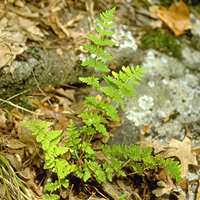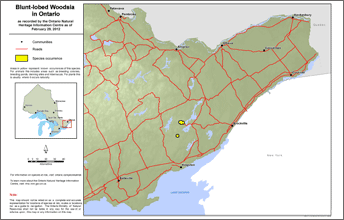Blunt-lobed woodsia
Scientific name: Woodsia obtusa

Cover photo credit: Donald Sutherland
Status
Endangered
"Endangered” means the species lives in the wild in Ontario but is facing imminent extinction or extirpation.
Date added to the Species at Risk in Ontario List
The Blunt-lobed woodsia was already assessed as endangered when the Endangered Species Act took effect in 2008.
What it looks like
Blunt-lobed Woodsia is a small to medium-sized fern that gets its name from the blunt, rounded lobes of its leaves, known as fronds.
The twice-divided bright green fronds may reach up to 60 centimetres in length and 15 centimetres in width.
They usually have eight to 17 pairs of leaflets. The leaf stalk is straw-coloured and brittle.
Where it lives
In Canada, Blunt-lobed Woodsia is found growing on steep chalky rock faces or escarpments on the Precambrian shield.
In Ontario, this species grows only in south-facing locations where the microclimate is warmer.
Due to relatively shallow soil over bedrock, the trees around the ferns are typically small to moderate in size and widely scattered.
Associated tree species are deciduous, including Sugar Maples, Oaks, White Ash and Ironwood.
Where it’s been found in Ontario
Blunt-lobed Woodsia is a relatively common species in the eastern United States. However, in Canada, there are only eight known populations, four in eastern Ontario and four in western Quebec.
In Ontario, Blunt-lobed Woodsia is concentrated at sites along the Frontenac Axis, all within approximately 20 kilometres of each other.
View a Larger version of this map (PDF)
What threatens it
The main limitation for Blunt-lobed Woodsia appears to be availability of suitable habitat. At one site in particular, Common Buckthorn, an invasive and non-native species, is considered a threat.
Development and site alteration are not primary threats, as most of the sites are located on steep rock faces not suitable for development.
Action we are taking
Endangered Species and their general habitat are automatically protected
Recovery strategy
A recovery strategy advises the ministry on ways to ensure healthy numbers of the species return to Ontario.
Read the executive summary and full document (June 15, 2017)
Government response statement
A government response statement outlines the actions the government intends to take or support to help recover the species.
Read the government response statement (February 27, 2018)
Review of Progress
A review of progress made toward protecting and recovering a species is required no later than the time specified in the species’ government response statement, or not later than five years after the government response statement is published if no time is specified.
Read the report on progress towards the protection and recovery of 11 species at risk, including Blunt-lobed Woodsia (2023).
Habitat protection
General Habitat Protection - June 30, 2008
What you can do
Report a sighting
- The Ministry of Natural Resources and Forestry tracks species at risk such as the Blunt-lobed woodsia. Report a sighting of an endangered animal or plant to the Natural Heritage Information Centre. Photographs with specific locations or mapping coordinates are always helpful.
Volunteer
- Volunteer with your local nature club or provincial park to participate in surveys or stewardship work focused on species at risk.
Be a good steward
- Private land owners have a very important role to play in species recovery. If you find a nesting on your land, you may be eligible for stewardship programs that support the protection and recovery of species at risk and their habitats.
- Invasive species seriously threaten many of Ontario’s species at risk. To learn what you can do to help reduce the threat of invasive species, visit:
www.ontario.ca/invasivespecies
www.invadingspecies.com
www.ontarioinvasiveplants.ca
Report illegal activity
- Report any illegal activity related to plants and wildlife to
1-877-TIP-SMNR (847-7667)
Quick facts
- Blunt-lobed Woodsia may live as long as several decades.
- Because Blunt-lobed Woodsia typically grows on steep, largely inaccessible slopes, there may be other populations that have not yet been discovered. The finding of one new population in Ontario in 2004, and two new populations in Quebec in 2000 and 2004, supports this possibility.
